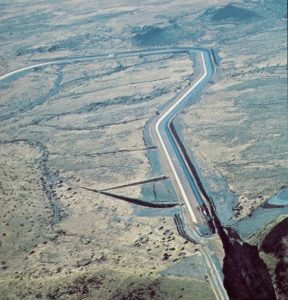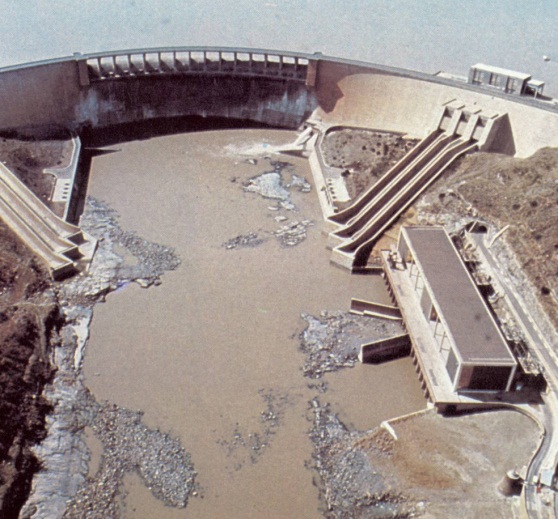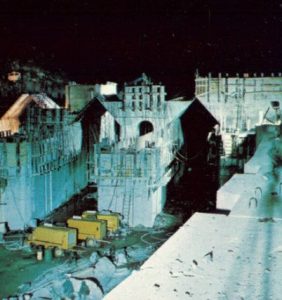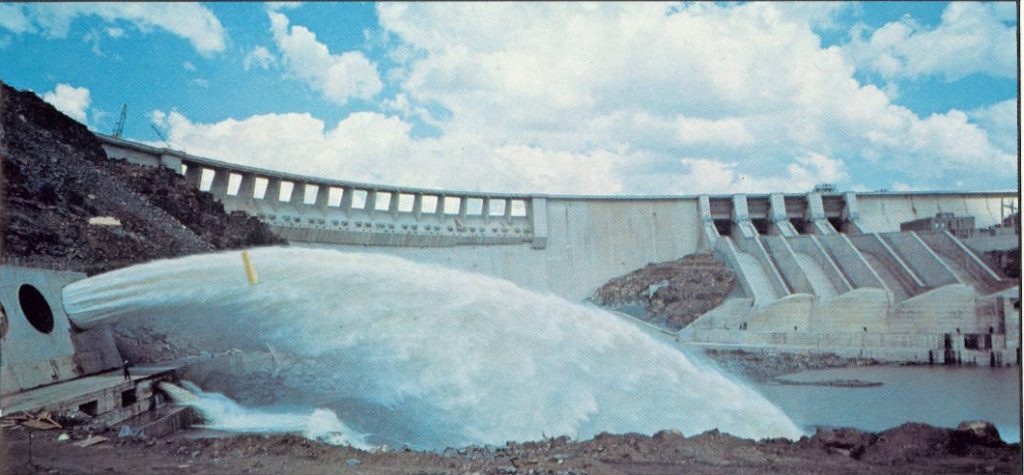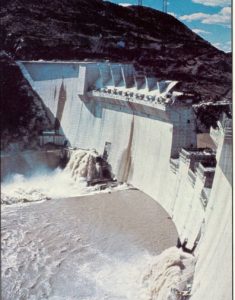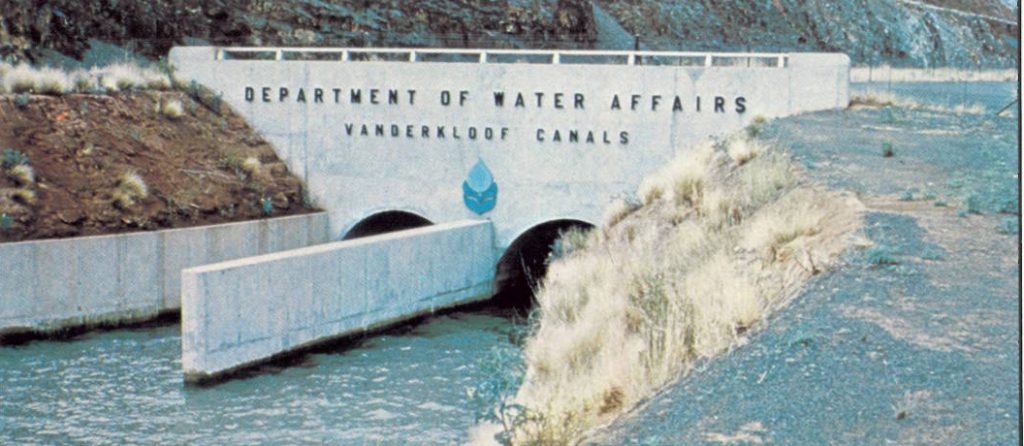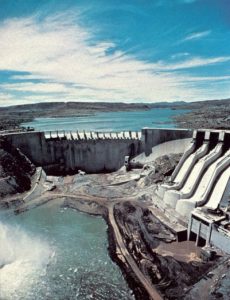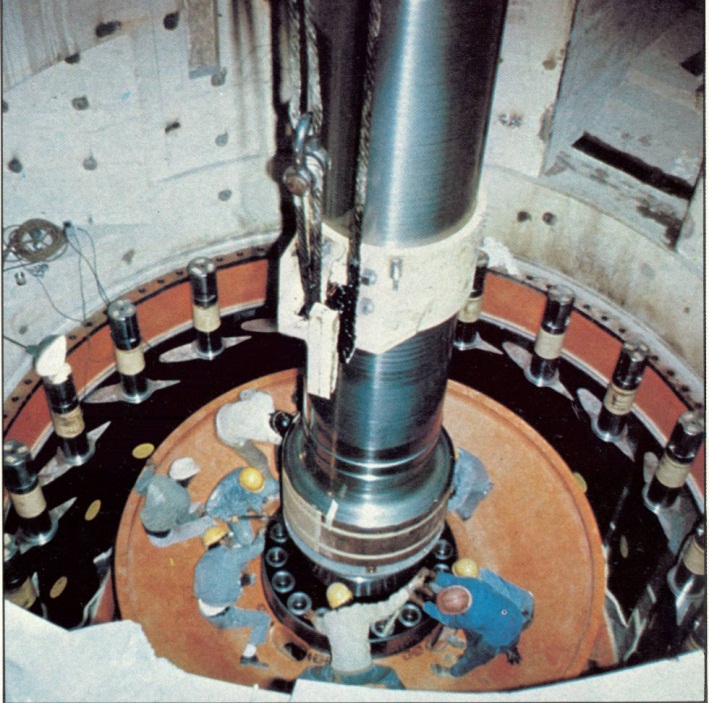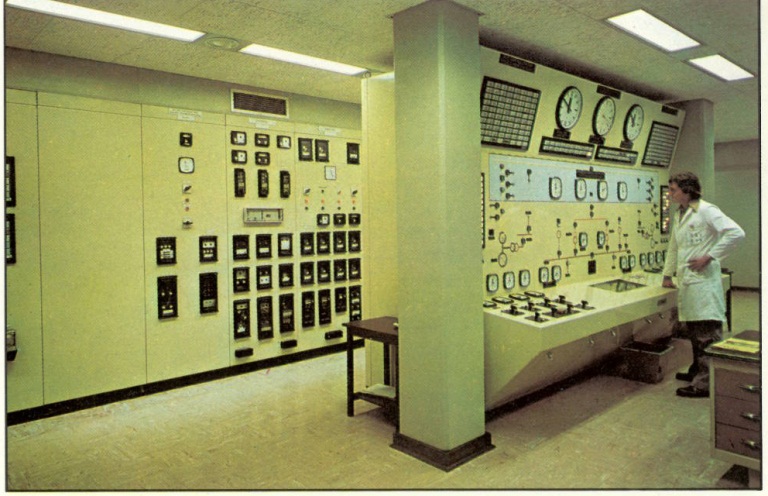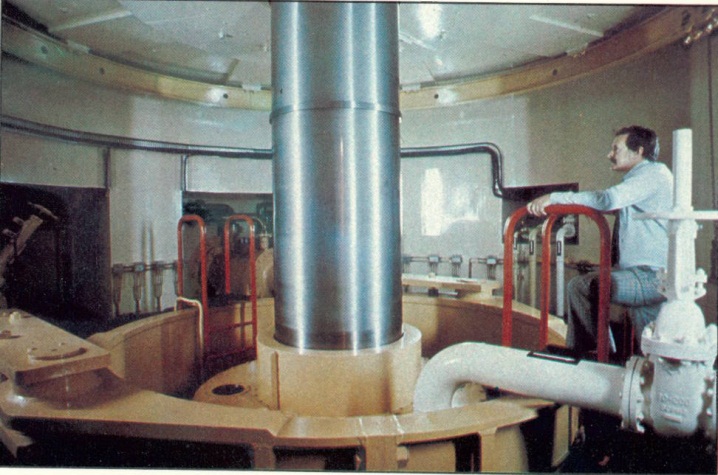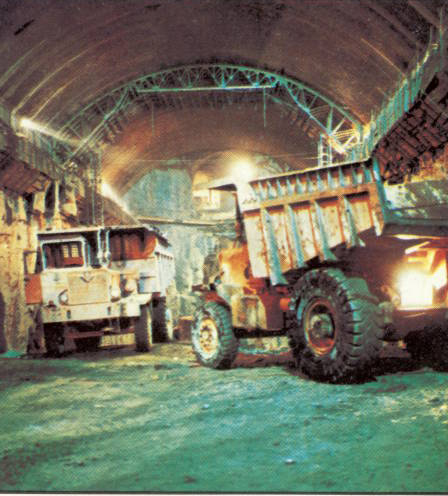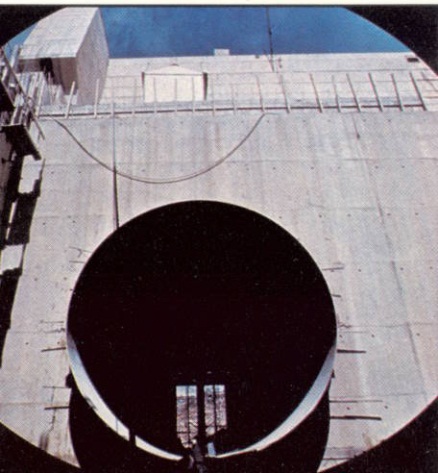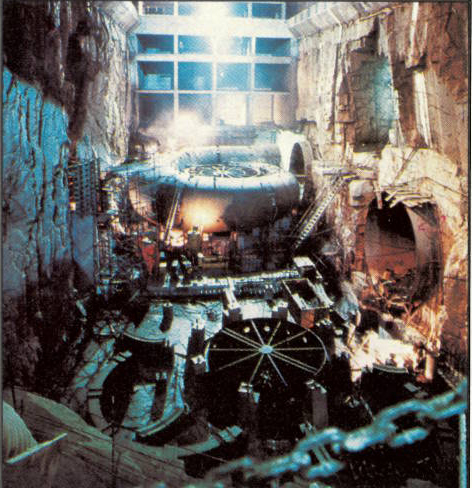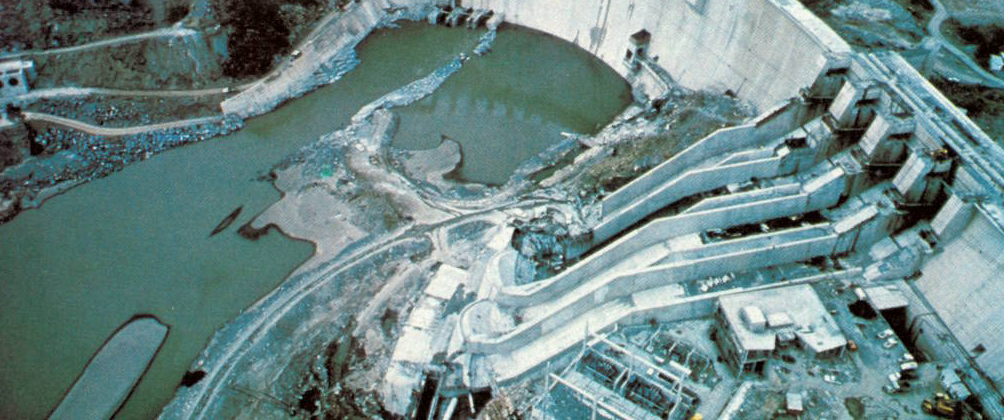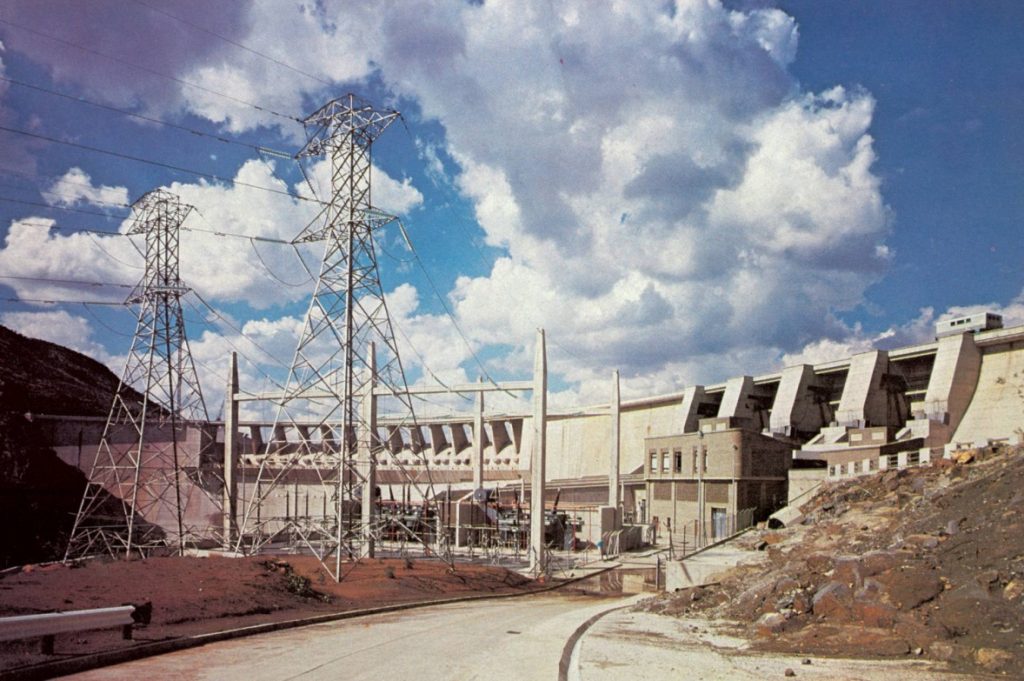Vanderkloof Power Station
The P K le Roux Dam forms part of the Orange River Project, the largest engineering and water conservation project ever attempted in South Africa. This combined storage and diversion dam also incorporates the Vanderkloof hydro-electric power station which is connected ESCOM’s national distribution. The dam was officially opened by the Prime Minister. The Honourable J Vorster on 17 November 1977. It is named after a former Minister of Water Affairs who for many years campaigned for the development of the Orange River.
ESCOM’s Vanderkloof Power Station is situated underground on the left bank (Cape side) of the P K le Roux Dam. It is the second hydro-power station made possible by the Orange River Project and was brought into full operation in 1977. The first, completed in 1972, is at Hendrik Verwoerd Dam, further upstream in the Orange River, Vanderkloof Power Station is named after the farm on which the P K le Roux Dam is situated.
Orange River Project
The Orange River rises in the Drakensberg inside the eastern boundary of Lesotho and flows in a westerly direction across South Africa for about 2 100 km through regions of steadily decreasing rainfall and increasing aridity until it finally reaches the Atlantic Ocean at Alexander Bay.
As far back as 1928 the idea of harnessing South Africa’s biggest river for the benefit of the whole country was being considered, and extensive investigations and planning, which later became the Department of Water Affairs, resulted in the While Paper for the Orange River Project (ORP) being tabled in Parliament in 1962.
Aerial view of construction work taking place in the river-bed section looking downstream
The project held far reaching implications. It meant that the arid semi desert area in the central part of South Africa could now be irrigated and existing water supplies could be augmented, providing food and water for millions of people. Further, it would contribute towards the decentralization of industry and this towards the most economic utilization of the country’s labour resources. Still further, it would establish stable farming communities and thus inhibit the flow of population from the country to the cities, while increasing the value of rand every year. Finally it would control the devastating flood to which the lower Orange River is periodically subjected.

The project made provision for:
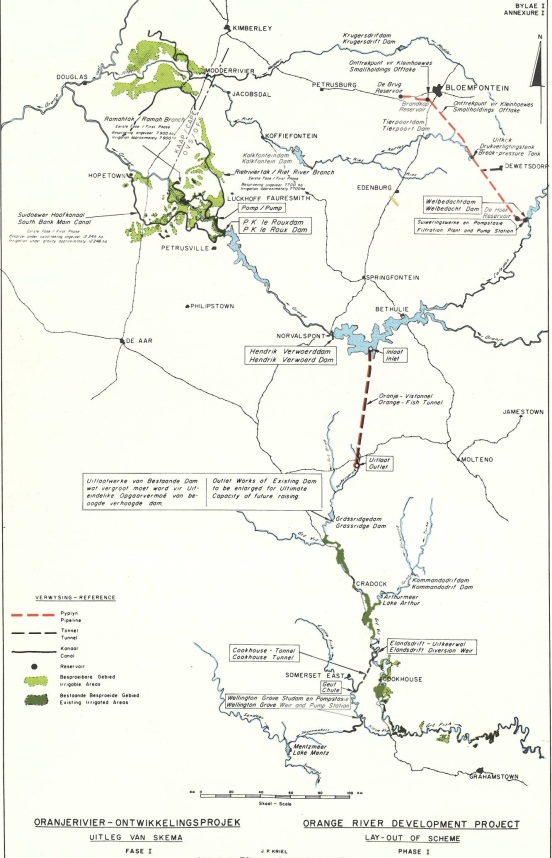
- A main storage dam, the Gariep Dam, in a narrow gorge 5 km upstream from Norvals-point in the north-eastern Cape
- A combined storage and diversion dam the P K le Roux Dam near Petrusville.
- The Orange Fish Tunnel, 82 km long and 5,3m in diameter, which carries water from the Gariep Dam under the Suurberg Plateau to the upper reaches of the Great Fish River.
- Hydro-electric power stations at Gariep and P K le Roux which feed power into Eskom’s national distribution network during peak hours and emergencies.
- An extended canal system which carries water to thousands of hectares of irrigable land in the valleys of the Orange and Fish Rivers.
- The Welbedacht Dam and water supply works in the Caledon River, one of the most important tributaries of the Orange River.
- A diversion dam and connecting canal and tunnel which carries water of the Orange River from the Fish River to Lake Mentz.
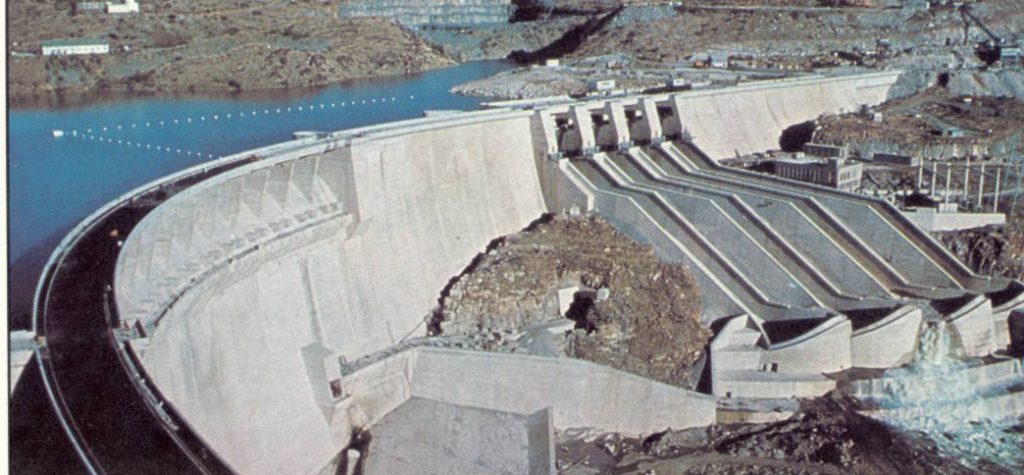
The Gariep Dam was officially opened on 3 March 1972 by the State President, Mr. J J Fouche and the Orange Fish Tunnel on 22 August 1975 by the Prime Minister Mr. B J Vorster, at a ceremony at Teebus near Steynsburg where the tunnel ends.
The P K le Roux Dam completes the major part of the gigantic Orange River Project and the country can now reap the full benefits of South Africa’s largest river.
Design of P K le Roux Dam
The P K le Roux Dam is 130 km down-stream of the Gariep Dam, near the town of Petrusville in the Northern Cape. It was planned as the second most important storage dam of the ORP and is the main control dam to release water into the river for us further down-stream and to divert water into the canal system and to divert water into the canal system which will eventually irrigate more than 1000 000 ha of land, mainly in the lower Riet River area. Water released into the river will also be used to generate electricity. To meet these requirements it was necessary to build a high dam wall with discharge and control structures also sited at a high level.
The design of the dam and the supervision of the construction were entrusted to consulting engineers.
A through study of various types of dam structures was carried out and it was found that, for the topography and favourable foundation conditions of the site, a double curvature arch dam with a gravity section on the left flank would be the most suitable structure. The dam has a centrally positioned spill-way section. In the left flank wall are four spillway chutes for the controlled release of water from the dam. The four 15 m by 9.5 m openings are controlled by radial gates which, in conjunction with the central spillway crest, discharge floodwater when the dam‘s storage capacity is exceeded. The normal river outlets as well as the right bank main canal outlet structure are on the right and the inlet to ESCOM’s underground power station is on the left flank. Provision has also been made for canal outlet structures on this flank. On each side of the spillway crest a slit outlet has been to discharge heavily slit-laden water, thereby minimizing the siltation of the dam. The various outlets described above are controlled by a system of valves and gates.
Preparatory Work
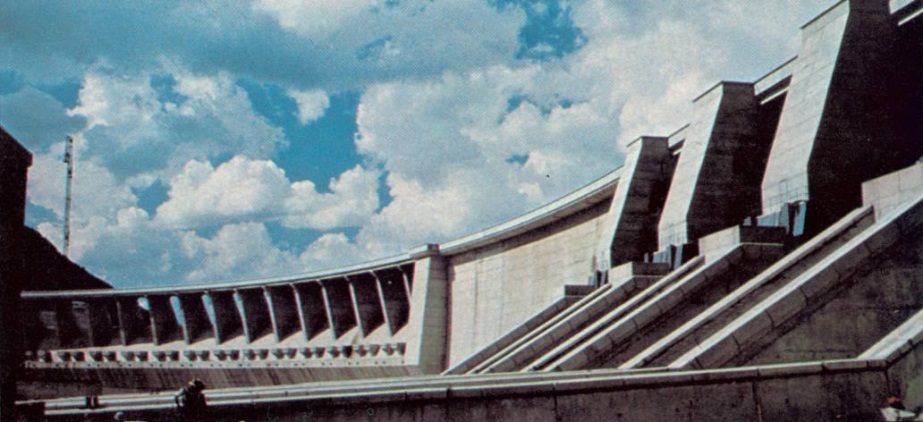
For the construction of the preliminary works such as access roads, buildings and sewerage, the first construction workers arrived on the site during August 1963. This work was completed in 1968. During October 1967 it was decided to delay construction of the dam temporarily in accordance with the Government’s policy to combat inflation. During this period the siting and design of the dam was reconsidered. It was decided to move the site of the structure about 200 m further downstream and this change resulted in a considerable saving in excavation and concrete costs.
Construction work
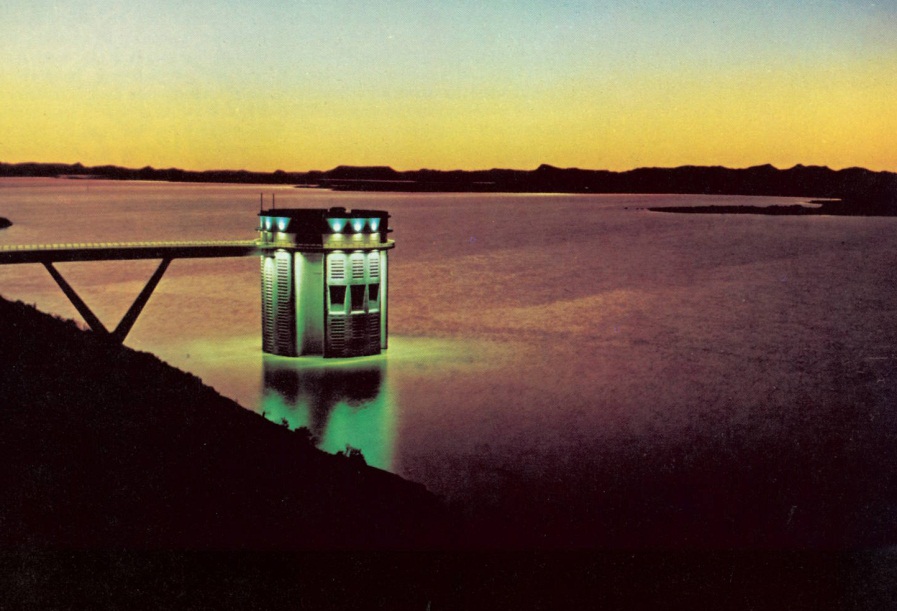
During 1969 the Cabinet decided to go ahead with the construction of the P K le Roux Dam and tenders for the civil works were obtained during 1970. The tenders were, however, considerably higher than had been expected and during March 1971 it was decided that the Department of Water Affairs should undertake the construction work itself. During July 1971 the first construction teams arrived at the site and two years later the first concrete was placed. During August 1973 the river was diverted through a temporary opening in the right flank of the wall and it was then possible to start with the foundation excavations of the river section.
Statistics of the Dam
All heights in metres above sea-level
River-bed level – 1089m (sand) – 1089m (rock)
Full supply level – 1170.50m
High flood levle – 1179.00m
Crest level (road) – 1180.00m
Maximum height above the river bed – 91m (sand) – 100 m (rock)
Crest length of dam wall – 770m
Gross storage capacity – 3255 million m³
Net storage above silt – 3237 million m³
Surface area of reservoir -13 866 ha
Volume of excavation – 2 429 million m³
Volume of concrete placed – 1 116 million m³
Capacity of spillway and outlets at high flood level
Spillway – 13 200 m³/s
4 Chute spillways – 2 160 x 4 = 8640 m³/s
4 River-flow outlets – 71 x 4 = 284 m³/s
2 Silt outlets – 187,5 x 2 = 375 m³/s
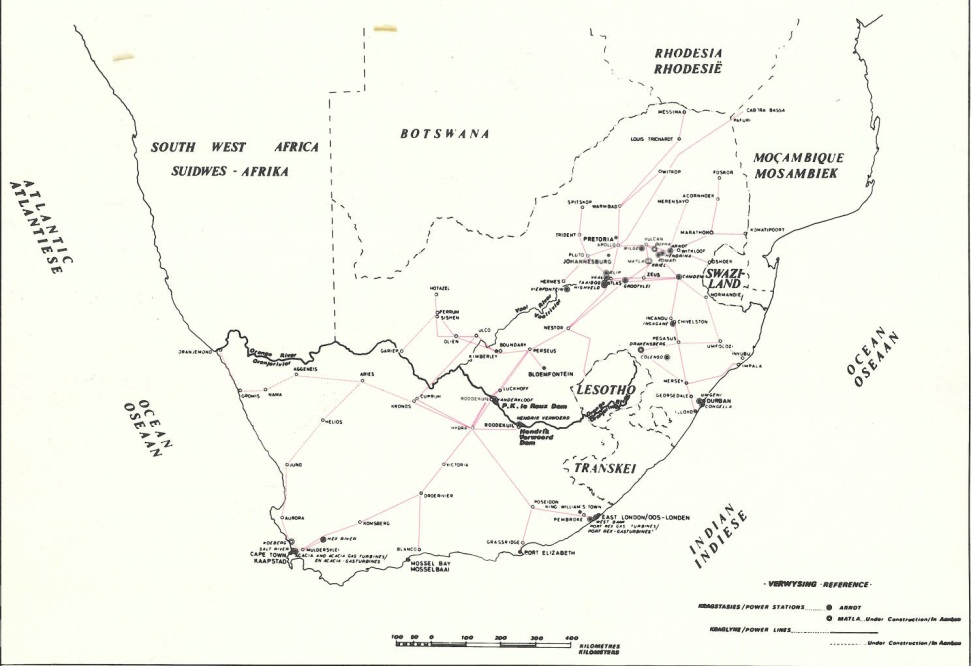
Planning and construction of the dam
The Department of Water Affairs planned and designed the Orange River Project and except for the construction of the Gariep Dam and the Orange Fish Tunnel, undertook the construction of the project itself. For the detailed designed of the P K le Roux Dam, the Department made use of the services of the following organizations:
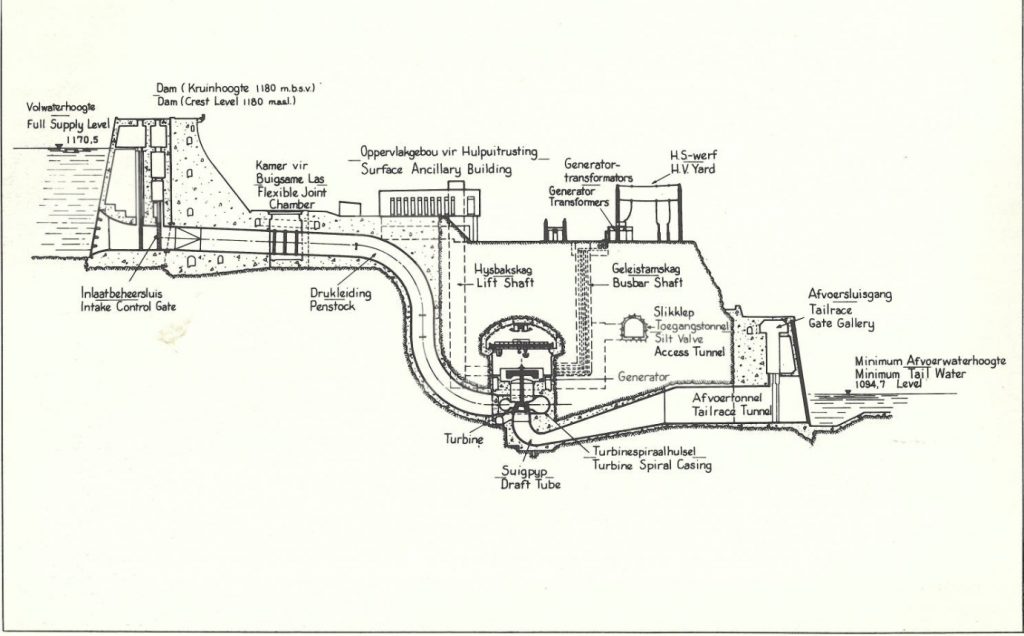
Gibb Hawkins and Partners, which incorporates Sir Alexander Hawkins and Osborn, Britain, Hawkins and Osborn, South Africa and International Orange River Consultants.
The Construction Division of the Department of Water Affairs undertook the construction of the civil works while the manufacture and erection of the gates inlet pipes and ancillary equipment was carried out by the firm Sorefame-Broderick. Cementation Engineering (Pty) Ltd was responsible for the manufacture and erection of the valves.
Eskom’s Vanderkloof power station is situated underground on the left bank (Cape side) of the P K le Roux Dam. It is the second hydro-power station made possible by the Orange River Project and was brought into full operation in 1977. The first, completed in 1972, was Gariep Dam, further upstream in the Orange River.
Vanderkloof power station is named after the farm on which the P K le Roux Dam is situated. Although South Africa’s hydro-electricity potential is limited it plays an important and integral part in the overall supply of electricity in this country. Covential hydro and pumped-storage plant is well suited to cater for peak demand periods and emergencies, it is not expensive to run, and can be brought into operation in a short time by remote control. Eskom’s association with hydro-electricity goes back to 1927 when the Sabie Gorge power station, consisting of three small 600 kVA sets was commissioned.
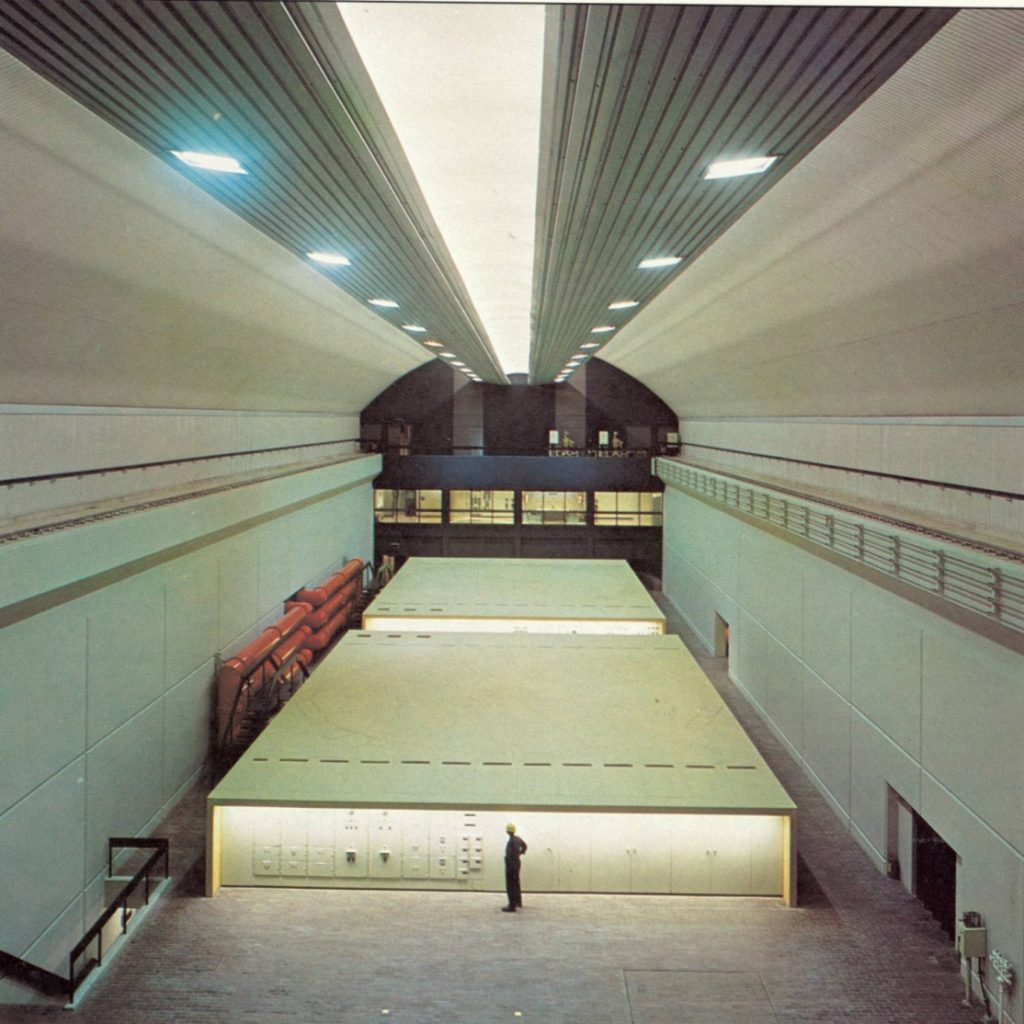
Design and construction of Vanderkloof
The natural flow of the Orange River fluctuated between drought and flood conditions, but is regulated first in the Gariep Dam and after discharge from the Gariep power station again in the P K le Roux Dam before utilisation in the Vanderkloof power station. Exploratory works and economic considerations at P K le Roux Dam indicated that the best position for the machine hall of the power station, where two turbo-generators are housed, is an an under-ground cavern below the dam wall on the left bank (Cape side) of the river. Just over 97 300 m³ of solid rock was removed to create this vast cavern 91,2 m long, 24,0 m wide and 48 m high. Staff and service access to the cavern is by way of a below the power station’s high-voltage yard. There is also a passenger lift which links the machine hall with the surface ancillary building situated just below the dam wall. Work on the site commenced in January 1973 and the station was in full operation by February 1977.
Plant and equipment
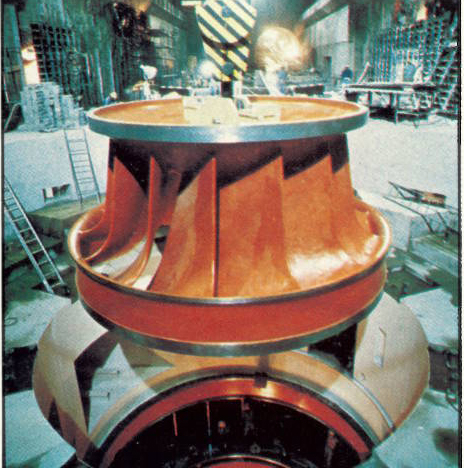
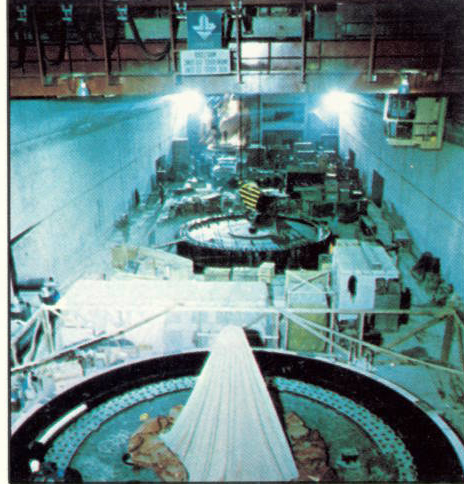
The underground machine hall houses two 120 MW turbine-generators each consisting of a medium head vertical Francis water turbine, directly coupled to an umbrella-type generator. The water to drive the turbine is conveyed from the dam through 7 m diameter steel-lined penstocks to the turbine spiral casing. Here control of the water flow, and hence load on the generator, is regulated by 20 hydraulically actuated guide vanes. The turbine water discharge is then conveyed via the draft tube and tailrace tunnel back into the Orange River downstream of the dam. The 11 kV generator, with totally enclosed air cooling circuit and air-to-water heat exchangers, is connected by phase-isolated bus-bars to 133-3 MVA 11/220 kV generator on the surface. From these transformers the power is conveyed to the Roodekuil distribution station 3 km away, which links up with the main 400-kV system at Hydra distribution station near De Aar.
Consultants:
Gibb Hawkins and Partners
Principal Statistics of the Vanderkloof Power station
Commencement of power station excavation -January 1973
Commercial service first machine: Set 1 – 22 December 1976
Second machine: Set 2 – 23 February 1977
Volume of underground rock excavation – 97 300 m³
Volume of concrete placed – 31 300 m³
Machine hall cavern
Length – 91,2 m
Width at vault – 24,0 m
Width between sidewalls – 19,2 m
Depth (vault to dewatering pit) – 48,6 m
Generator design output – 120 MW at 0,90 power factor lagging
Speed of machine – 125 r/min
Generator nominal voltage – 11 kV
Generator transformer voltage – 11/220 kV
Type of hydro-turbine – Vertical Francis
Design net head of turbine – 65,0 m
Water consumption per turbine up to – 217 cumecs
Inlet diameter to turbine spiral casing – 7,0 m
Turbine runner diameter – 5462 mm
Turbine runner material – Stainless cast steel
Total load on thrust bearing – 14 MN
Intake control gate size – 7,0 m
Tailrace gate size – 5,5 m wide x 7,2 m high
Machine hall overhead travelling crane capacity- 100/25 t
Masses of equipment:
Generator rotor – 436 t
Turbine runner – 54 t
Turbine/generator shaft – 60 t
Intake control gate – 40 t
Tailrace gate – 57 t

